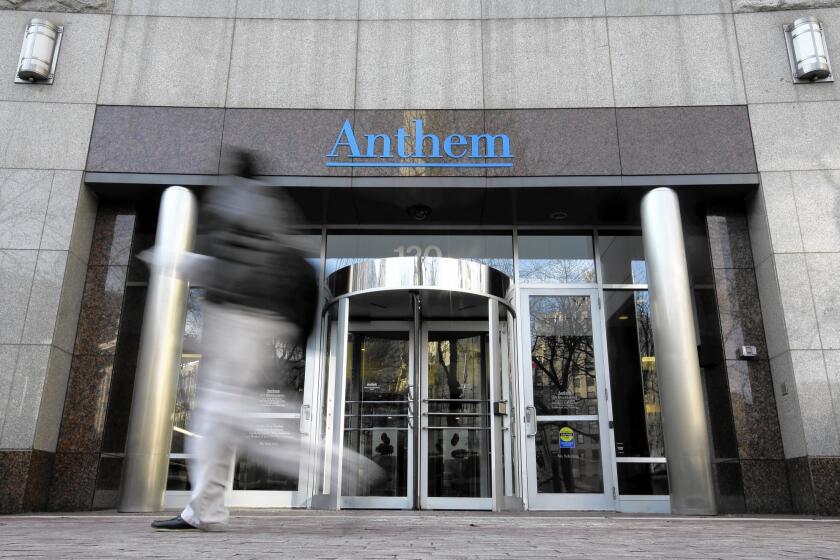Some are getting new California health insurance subsidies. Others get shut out

Syd Winlock bought one of the cheapest health insurance policies he could find for himself and his wife, Lisa, this year: a high-deductible plan with lousy coverage and a $1,500-a-month price tag.
For coverage next year, the Elk Grove, Calif., resident qualifies for new state-funded health insurance subsidies totaling about $870 a month. This aid allows him to buy a better plan with a lower deductible for about $1,200 a month.
That’s still high, he said, but any help is welcome.
“It made a huge difference,” said Winlock, 61, a small-business owner who provides accounting and point-of-sales systems to other businesses. “We were thinking that in 2020 we wouldn’t be able to keep our plan,” let alone afford an upgrade, he said.
Heather Altman, an independent environmental consultant in Long Beach, also hoped to qualify for the new state financial aid. But after checking with a health insurance agent, she learned she won’t get anything. “At first I thought it might be a mistake,” she said. “It was disappointing.”
Starting Jan. 1, California will offer financial aid to some consumers who buy health coverage through Covered California, the state’s Affordable Care Act insurance exchange.
Some of the subsidies will go to people who already qualify for the federal tax credits available to some Covered California consumers, primarily those with low incomes. But the assistance will also be extended to middle-income people such as Winlock who make too much money to qualify for the federal tax credits and have had to bear the entire cost of their premiums. California will be the first state to offer such help to middle-class consumers.
With open enrollment for Covered California going full steam — sign-ups for 2020 coverage end Jan. 31 — consumers are eagerly trying to determine whether they might qualify for the new aid and, if so, how much.
The results are mixed.
“It’s brought higher-income earners to call me, but most still earn too much” to qualify, said Kevin Knauss, a Sacramento-area insurance agent who also has clients in Los Angeles and the San Francisco Bay Area. “Others are picking up $15 to $25.”
More than 486,000 people have already qualified for the new state subsidies, with more expected as open enrollment continues, Covered California announced Thursday. This includes about 23,000 middle-income enrollees who make too much to qualify for federal tax credits, said Covered California Executive Director Peter Lee.
New enrollment is up by 16% compared with this time last year, largely because of the new state financial aid and health insurance requirement, Lee said.
This “is a small slice of who will sign up,” he said. “We’re optimistic there will be many, many more people covered by these state subsidies for the middle class.”
Californians must have health insurance in 2020 or face a penalty. But some will be exempt.
This year, Gov. Gavin Newsom signed a 2019-20 state budget that includes nearly $429 million for the subsidies. To help pay for them, the state is imposing a tax penalty starting next year on people who don’t have health insurance — similar to the federal penalty the Republican-controlled Congress eliminated effective this year.
Covered California has estimated that nearly 1 million Californians could benefit from the new state money.
Some of the aid will go to low- and moderate-income people who earn 200% to 400% of the federal poverty level, or roughly $25,000 to $50,000 for an individual and $51,500 to $103,000 for a family of four, based on 2019 figures. This group also qualifies for federal tax credits. The average household state subsidy in this category would be $21 a month, Covered California estimates.
The majority of the state assistance, however, will go to people whose incomes are 400% to 600% of the poverty level — too high for federal aid but still low enough to make healthcare financially challenging. That’s about $50,000 to $75,000 a year for an individual and $103,000 to $154,500 for a family of four. The average state assistance for this group will be about $460 a month, according to Covered California.
But falling into this income bracket doesn’t guarantee subsidies, as Altman learned.
She estimated she will make $60,000 next year, which puts her within the income range to qualify as an individual. But she won’t be getting any aid, and she doesn’t quite understand why.
Besides income, household size, location and age play a role in eligibility for the subsidies, Covered California’s Lee said. For example, older people who live in areas with high healthcare costs have a higher chance of getting help, he said.
Altman, 47, who has severe asthma and is on multiple medications, said she can’t go without coverage, so she will pay $640 a month for a health plan next year, up $70 from this year.
“I was just glad that it was only an 11% increase,” she said. “In previous years, I’ve seen a 20-something percent increase.”
Winlock said he feels grateful he qualified for the state financial aid because it allowed him to buy a better plan. Now he can seek care that he has been avoiding.
“We’re pretty healthy, and I’m very active, but I do have an issue with arthritis that I haven’t been pursuing because just testing alone is very expensive,” he said.
Evette Tsang, an insurance agent in Sacramento, said that although news of financial aid is driving some customers to her office, the new insurance requirement — and the accompanying tax penalty — are ultimately motivating most people to sign up.
People who don’t have insurance in 2020 will have to pay the penalty when they file their state tax returns in 2021. The penalty will amount to $695 for an adult and half that much for dependent children. Some people with higher incomes instead will have to pay 2.5% of their income, which could make their penalty quite a bit heftier.
Tsang saw clients drop their coverage when the federal penalty was eliminated. “Now they’re coming back,” she said.
Ana B. Ibarra writes for Kaiser Health News, an editorially independent publication of the Kaiser Family Foundation.
More to Read
Inside the business of entertainment
The Wide Shot brings you news, analysis and insights on everything from streaming wars to production — and what it all means for the future.
You may occasionally receive promotional content from the Los Angeles Times.











